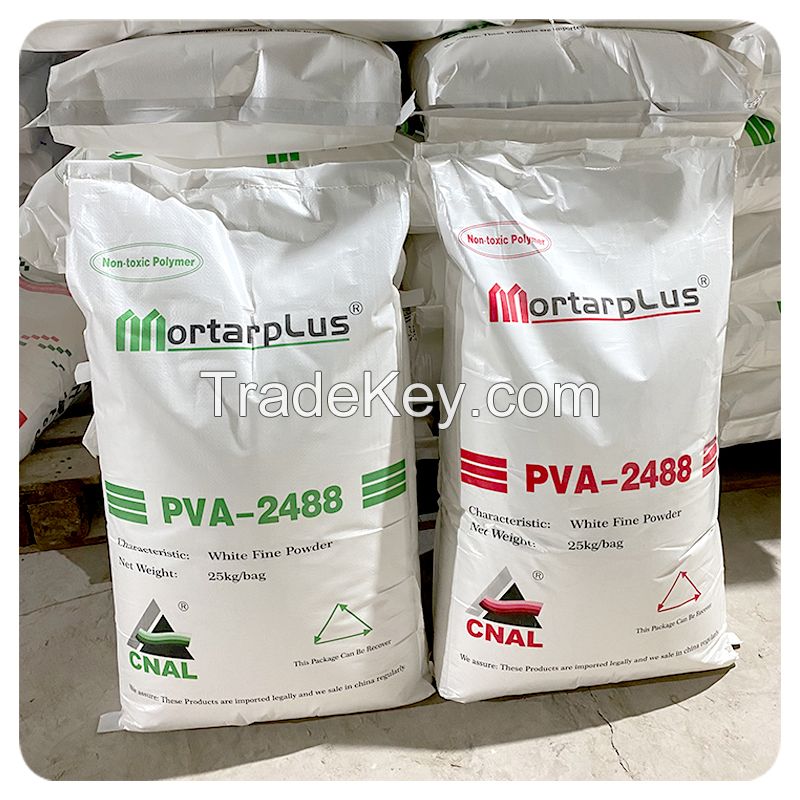Polyvinyl
alcohol is an excellent water-based adhesive
property. Generally speaking, the product is
in the form of flakes, granules or flocs. It
is not easily dissolved in cold water, when
it is dissolved, heating is generally
required. This property greatly limits its
application range. However, if subjecting it
to fine pulverization and surface treatment,
it will have a good cold water solubility.
But due to its thermoplasticity, it is
difficult to be in the pulverization
process.
The vinyl acetate
is generated by the polymerization of vinyl
acetate and then the polyvinyl alcohol with
different degree of alcoholysis can be
gained through the polyvinyl acetate in
different alkali amount. The cold-soluble
polyvinyl alcohol powder a water-soluble
environment-friendly white solid powder
prepared by deep-cooling milling of a
partially alcoho-decomposing polyvinyl
alcohol.
It has good film
forming properties and adhesion, solvent
resistance, abrasion resistance and tensile
strength.
The particles are
fine, the amount of addition is small, and
it is easy to disperse. It can be dissolved
in cold water. Providing good bonding
properties and increasing mortar strength.
Prevention cracking and detachment of
mortar, increasing the adhesion strength
and
smoothness.This
product is non-toxic, tasteless and
environmental
friendly.
PVA
is used in a variety of medical
applications because of its
biocompatibility, low tendency for protein
adhesion, and low toxicity. Specific uses
include cartilage
replacements, contact
lenses, and eye
drops.[5] Polyvinyl
alcohol is used as an aid
in suspension
polymerizations. Its largest
application in China is its use as a
protective colloid to
make polyvinyl
acetate dispersions. In Japan
its major use is the production
of Vinylon fiber.This
fiber is also manufactured
in North
Korea for self-sufficiency
reasons, because no oil is
required to produce it. Another application
is photographic film.
Nowadays
PVA-based polymers are being used widely in
additive manufacturing. For example, 3D
printed oral dosage forms demonstrate great
potential in the pharmaceutical industry.
It is possible to create drug-loaded
tablets with modified drug-release
characteristics where PVA is used as a
binder substance. Medically,
it may also used as the embolic agent in a
Uterine Fibroid Embolectomy
(UFE)
Polyvinyl acetals are
prepared by treating PVA
with aldehydes. Butyraldehyde and formaldehyde afford polyvinyl
butyral (PVB)
and polyvinyl
formal (PVF), respectively.
Preparation of polyvinyl butyral is the
largest use for polyvinyl alcohol in the
U.S. and Western
Europe.
Preparation
Unlike
most vinyl
polymers, PVA is not prepared by
polymerization of the
corresponding monomer as
the monomer, vinyl
alcohol, is thermodynamically
unstable with respect to
its tautomer acetaldehyde.
Instead, PVA is prepared by hydrolysis
of polyvinyl
acetate,[3] or
sometimes other vinyl ester-derived
polymers with formate or chloroacetate
groups instead of acetate. The conversion
of the polyvinyl esters is usually
conducted by
base-catalysed transesterification with
ethanol:
[CH2CH(OAc)]n +
C2H5OH
→ [CH2CH(OH)]n +
C2H5OAcThe
properties of the polymer are affected by
the degree of transesterification.
Worldwide consumption of polyvinyl alcohol
was over one million metric tons in
***6.Large producers
include Kuraray (Japan,
Europe, and US) and Sekisui Specialty
Chemicals (US), while mainland China has
installed a number of very large production
facilities in the past decade and currently
accounts for *5% of world
capacity.
Structure and
properties
PVA is
an atactic material
that exhibits crystallinity.
In terms of microstructure, it is composed
mainly of 1,*-diol linkages
[-CH2-CH(OH)-CH2-CH(OH)-]
but a few percent of 1,*-diols
[-CH2-CH(OH)-CH(OH)-CH2-]
occur, depending on the conditions for the
polymerization of the vinyl ester
precursor.
Polyvinyl alcohol
has excellent film
forming, emulsifying and adhesive properties.
It is also resistant to oil, grease
and solvents.
It has high tensile strength and
flexibility, as well as high oxygen and
aroma barrier properties. However, these
properties are dependent
on humidity:
water absorbed at higher humidity levels
acts as a plasticiser, which reduces the
polymer's tensile strength, but increases
its elongation and tear
strength.
Safety and
environmental
considerations
PVA is widely
used, thus its toxicity and biodegradation
are of interest. Solutions containing up to
5% PVA are nontoxic to fish. It
biodegrades
slowly。





